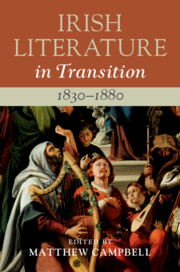Book contents
- Irish Literature in Transition, 1830–1880
- Irish Literature in Transition
- Irish Literature in Transition, 1830–1880
- Copyright page
- Contents
- Contributors
- Series Preface
- General Acknowledgements
- Acknowledgements
- Part I Contexts and Contents: Politics and Periodicals
- Part II Ireland and the Liberal Arts and Sciences
- Part III From the Four Nations to the Globalising Irish
- Part IV The Languages of Literature
- Chapter 12 Antiquarians and Authentics: Survival and Revival in Gaelic Writing
- Chapter 13 Poetry and Its Audiences: Club, Street, Ballad
- Chapter 14 Realism, Allegory, Gothic: The Irish Victorian Novel
- Chapter 15 The Rise of the Woman Writer
- Chapter 16 Dion Boucicault and the Globalised Irish Stage
- Chapter 17 Popular Prints
- Index
Chapter 17 - Popular Prints
from Part IV - The Languages of Literature
Published online by Cambridge University Press: 29 February 2020
- Irish Literature in Transition, 1830–1880
- Irish Literature in Transition
- Irish Literature in Transition, 1830–1880
- Copyright page
- Contents
- Contributors
- Series Preface
- General Acknowledgements
- Acknowledgements
- Part I Contexts and Contents: Politics and Periodicals
- Part II Ireland and the Liberal Arts and Sciences
- Part III From the Four Nations to the Globalising Irish
- Part IV The Languages of Literature
- Chapter 12 Antiquarians and Authentics: Survival and Revival in Gaelic Writing
- Chapter 13 Poetry and Its Audiences: Club, Street, Ballad
- Chapter 14 Realism, Allegory, Gothic: The Irish Victorian Novel
- Chapter 15 The Rise of the Woman Writer
- Chapter 16 Dion Boucicault and the Globalised Irish Stage
- Chapter 17 Popular Prints
- Index
Summary
This chapter explores the development of a popular print culture in Ireland during the decades between 1830 and 1880, as well as the growth of an audience for such publications. It traces the history of the technological and legislative changes – such as the arrival of steam presses and the abolition of stamp and paper taxes – necessary for a popular press to emerge, as well as the social and political landscape which enabled an expanded readership to develop. In particular, the chapter examines the role of the radical political press in actively developing that readership through both its network of reading rooms across Ireland and its publishing of newspapers and juvenile story papers, including the Nation newspaper, the Irish Fireside Magazine, Young Ireland and the Shamrock magazine. These publications were intended to establish an imaginative link between popular entertainment and radical politics, especially through the use of Irish history and historical fiction in order to create a print culture which created and reinforced a national Irish audience for both the popular press and mass political movements.
- Type
- Chapter
- Information
- Irish Literature in Transition, 1830–1880 , pp. 299 - 317Publisher: Cambridge University PressPrint publication year: 2020

